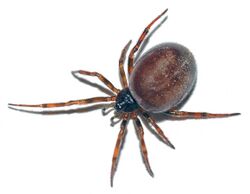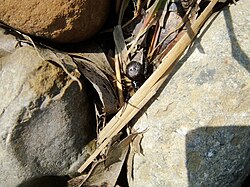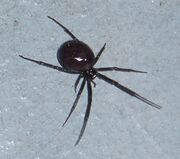Biology:Steatoda
| Steatoda | |
|---|---|

| |
| Female Steatoda bipunctata | |
| Scientific classification | |
| Domain: | Eukaryota |
| Kingdom: | Animalia |
| Phylum: | Arthropoda |
| Subphylum: | Chelicerata |
| Class: | Arachnida |
| Order: | Araneae |
| Infraorder: | Araneomorphae |
| Family: | Theridiidae |
| Genus: | Steatoda Sundevall, 1833[1] |
| Species | |
|
See text. | |
| Diversity[1] | |
| 118 species | |
The spider genus Steatoda, in the family Theridiidae, includes about 120 recognized species, distributed around the world (including many cosmopolitan species which are found among human populations worldwide).[2] One common name is cupboard spider, for many species build their webs in dark, sheltered, undisturbed places around the house or garden, in sheds and garages, under garden , compost bins, and the like. Signs of the cupboard spider include small white spots of spider droppings, like small splashes of paint, on the floor underneath the web.[3]
Many spiders of the genus Steatoda are often mistaken for widow spiders (Latrodectus), and are known as false widows. They are closely related (in the family Theridiidae) but Steatoda are significantly less harmful to humans. Not all Steatoda species resemble black widows – they come in many different colors and sizes, mostly smaller than Latrodectus species. Steatoda paykulliana can grow larger than the black widow, and Steatoda castanea looks more like a brown widow.
Description
The colour can range from sandy pale brown to reddish plum to satiny black. Like most spiders, its cephalothorax is smaller than its abdomen, which is somewhat egg-shaped, and can have white or beige to orange markings. Although sometimes not or partially visible, these markings usually consists of a frontal crescent, often with a dorsal line or triangular shapes or both. Orange to reddish-marked Steatoda paykulliana can be mistaken for the redback spider).
In common with other members of the family Theridiidae, Steatoda construct a tangled web, i.e., an irregular tangle of sticky silken fibers. These spiders have very poor eyesight and depend mostly on vibrations reaching them through their webs to orient themselves to prey or to warn them of larger animals that could injure or kill them.
Species
(As of October 2021), the World Spider Catalog accepted the following extant species:[1]
- Steatoda adumbrata (Simon, 1908) – Australia (Western Australia)
- Steatoda aethiopica (Simon, 1909) – Central Africa
- Steatoda alamosa Gertsch, 1960 – US, Mexico
- Steatoda alboclathrata (Simon, 1897) – India
- Steatoda albomaculata (De Geer, 1778) – North America, Europe, North Africa to Israel, Russia (Europe to Far East), Central Asia, China, Korea, Japan
- Steatoda ancora (Grube, 1861) – Russia (south Siberia)
- Steatoda ancorata (Holmberg, 1876) – Mexico to Chile
- Steatoda andina (Keyserling, 1884) – Venezuela to Chile
- Steatoda apacheana Gertsch, 1960 – US
- Steatoda atascadera Chamberlin & Ivie, 1942 – US
- Steatoda atrocyanea (Simon, 1880) – New Caledonia, Loyalty Is.
- Steatoda autumnalis (Banks, 1898) – Mexico
- Steatoda badia (Roewer, 1961) – Senegal
- Steatoda bertkaui (Thorell, 1881) – Indonesia (Moluccas), New Guinea
- Steatoda bipunctata (Linnaeus, 1758) (type species) – Europe, Turkey, Caucasus, Russia (Europe to Far East), Iran, Central Asia, China. Introduced to South America
- Steatoda borealis (Hentz, 1850) – US, Canada
- Steatoda bradyi (Strand, 1907) – South Africa
- Steatoda capensis Hann, 1990 – South Africa, Lesotho. Introduced to St. Helena, Australia, New Zealand
- Steatoda carbonaria (Simon, 1907) – Congo, Equatorial Guinea (Bioko)
- Steatoda caspia Ponomarev, 2007 – Kazakhstan
- Steatoda castanea (Clerck, 1757) – Europe, Turkey, Russia (Europe to Far East), Caucasus, Iran, Central Asia, China. Introduced to Canada
- Steatoda chinchipe Levi, 1962 – Ecuador, Peru
- Steatoda cingulata (Thorell, 1890) – China, India, Korea, Vietnam, Laos, Japan, Indonesia (Sumatra, Java)
- Steatoda connexa (O. Pickard-Cambridge, 1904) – South Africa
- Steatoda craniformis Zhu & Song, 1992 – China
- Steatoda dahli (Nosek, 1905) – Turkey, Israel, Caucasus, Russia (Europe) to Central Asia
- Steatoda diamantina Levi, 1962 – Brazil
- Steatoda distincta (Blackwall, 1859) – Madeira
- Steatoda ephippiata (Thorell, 1875) – Algeria to Israel, Iran
- Steatoda erigoniformis (O. Pickard-Cambridge, 1872) – East Mediterranean to Middle East, Caucasus, China, Korea, Japan. Introduced to the Caribbean.
- Steatoda fagei (Lawrence, 1964) – South Africa
- Steatoda fallax (Blackwall, 1865) – Cape Verde Is.
- Steatoda felina (Simon, 1907) – Congo
- Steatoda foravae Dippenaar-Schoeman & Müller, 1992 – South Africa
- Steatoda grandis Banks, 1901 – US
- Steatoda grossa (C. L. Koch, 1838) – Europe, Turkey, Caucasus, Russia (Europe to Far East), Central Asia, China, Korea, Japan. Introduced to North America, Ecuador, Peru, Chile, Hawaii Is., Macaronesia, Algeria, New Zealand
- Steatoda gui Zhu, 1998 – China
- Steatoda hespera Chamberlin & Ivie, 1933 – US, Canada
- Steatoda hui Zhu, 1998 – China
- Steatoda ifricola Lecigne, Lips, Moutaouakil & Oger, 2020 – Morocco
- Steatoda iheringi (Keyserling, 1886) – Brazil, Paraguay, Argentina
- Steatoda incomposita (Denis, 1957) – Portugal, Spain, France (incl. Corsica)
- Steatoda kiwuensis (Strand, 1913) – Central Africa
- Steatoda kuytunensis Zhu, 1998 – China
- Steatoda latifasciata (Simon, 1873) – Canary Is. to Israel
- Steatoda lawrencei Brignoli, 1983 – South Africa
- Steatoda lenzi (Strand, 1907) – South Africa
- Steatoda leonardi (Thorell, 1898) – Myanmar
- Steatoda lepida (O. Pickard-Cambridge, 1880) – New Zealand
- Steatoda linzhiensis Hu, 2001 – China
- Steatoda livens (Simon, 1894) – Australia (Tasmania)
- Steatoda longurio (Simon, 1909) – Central Africa
- Steatoda mainlingensis (Hu & Li, 1987) – Kyrgyzstan, China
- Steatoda mainlingoides Yin, Griswold, Bao & Xu, 2003 – China
- Steatoda marmorata (Simon, 1910) – South Africa
- Steatoda marta Levi, 1962 – Colombia
- Steatoda maura (Simon, 1909) – Mediterranean
- Steatoda mexicana Levi, 1957 – US, Mexico
- Steatoda micans (Hogg, 1922) – Vietnam
- Steatoda minima (Denis, 1955) – Niger
- Steatoda moerens (Thorell, 1875) – Algeria, Tunisia
- Steatoda moesta (O. Pickard-Cambridge, 1896) – Mexico to Brazil
- Steatoda morsitans (O. Pickard-Cambridge, 1885) – South Africa
- Steatoda nahuana Gertsch, 1960 – Mexico
- Steatoda nasata (Chrysanthus, 1975) – Indonesia (Krakatau), Papua New Guinea (New Ireland), Australia
- Steatoda ngipina Barrion & Litsinger, 1995 – Philippines
- Steatoda nigrimaculata Zhang, Chen & Zhu, 2001 – China
- Steatoda nigrocincta O. Pickard-Cambridge, 1885 – China (Yarkand)
- Steatoda niveosignata (Simon, 1908) – Australia (Western Australia)
- Steatoda nobilis (Thorell, 1875) – Macaronesia. Introduced to US, Chile, Europe, Turkey, Iran
- Steatoda octonotata (Simon, 1908) – Australia (Western Australia)
- Steatoda palomara Chamberlin & Ivie, 1935 – US
- Steatoda panja Barrion, Barrion-Dupo & Heong, 2013 – China
- Steatoda pardalia Yin, Griswold, Bao & Xu, 2003 – China
- Steatoda paykulliana (Walckenaer, 1806) – Europe, Mediterranean to Central Asia
- Steatoda pengyangensis Hu & Zhang, 2012 – China
- Steatoda perakensis Simon, 1901 – Malaysia
- Steatoda perspicillata (Thorell, 1898) – Myanmar
- Steatoda picea (Thorell, 1899) – Cameroon
- Steatoda porteri (Simon, 1900) – Chile
- Steatoda punctulata (Marx, 1898) – US, Mexico
- Steatoda quadrimaculata (O. Pickard-Cambridge, 1896) – US to Venezuela, Caribbean
- Steatoda quaesita (O. Pickard-Cambridge, 1896) – Mexico
- Steatoda quinquenotata (Blackwall, 1865) – Cape Verde Is.
- Steatoda retorta González, 1987 – Argentina
- Steatoda rhombifera (Grube, 1861) – Russia (middle Siberia)
- Steatoda rubrocalceolata (Simon, 1907) – Equatorial Guinea (Bioko)
- Steatoda rufoannulata (Simon, 1899) – India, Sri Lanka, Sumatra, Java
- Steatoda sabulosa (Tullgren, 1901) – Bolivia, Argentina, Chile
- Steatoda sagax (Blackwall, 1865) – Cape Verde Is.
- Steatoda saltensis Levi, 1957 – Mexico
- Steatoda seriata (Simon, 1899) – Indonesia (Sumatra)
- Steatoda singoides (Tullgren, 1910) – Tanzania
- Steatoda sordidata O. Pickard-Cambridge, 1885 – China (Yarkand)
- Steatoda speciosa (Thorell, 1898) – Myanmar
- Steatoda spina Gao & Li, 2014 – China
- Steatoda subannulata (Kulczyński, 1911) – New Guinea, Papua New Guinea (New Britain)
- Steatoda terastiosa Zhu, 1998 – China
- Steatoda terebrui Gao & Li, 2014 – China
- Steatoda tigrina (Tullgren, 1910) – Tanzania
- Steatoda tortoisea Yin, Griswold, Bao & Xu, 2003 – China
- Steatoda transversa (Banks, 1898) – US, Mexico
- Steatoda trianguloides Levy, 1991 – France (Corsica), Israel
- Steatoda triangulosa (Walckenaer, 1802) – Europe, Turkey, Caucasus, Russia (Europe to Far East), Central Asia. Introduced to Canada, US, Canary Is.
- Steatoda tristis (Tullgren, 1910) – Tanzania
- Steatoda truncata (Urquhart, 1888) – New Zealand
- Steatoda ulleungensis Paik, 1995 – Korea
- Steatoda uncata Zhang, Chen & Zhu, 2001 – China
- Steatoda variabilis (Berland, 1920) – East Africa
- Steatoda variata Gertsch, 1960 – US, Mexico
- Steatoda variipes (Keyserling, 1884) – Peru
- Steatoda vaulogeri (Simon, 1909) – Vietnam
- Steatoda venator (Audouin, 1826) – Libya, Egypt
- Steatoda violacea (Strand, 1906) – Ethiopia
- Steatoda wangi Zhu, 1998 – China
- Steatoda wanshou Yin, 2012 – China
- Steatoda washona Gertsch, 1960 – US, Mexico
- Steatoda xerophila Levy & Amitai, 1982 – Israel
- Steatoda xishuiensis Zhang, Chen & Zhu, 2001 – China
Those commonly mistaken for widows include:
- S. borealis. A common species in North America, often mistaken for the black widow (despite being smaller and having colored markings on the dorsal side of the abdomen, rather than the ventral side).
- S. capensis, the black cobweb or false katipo spider. It originates in South Africa, and is found in Australia and New Zealand; in the latter location it is often confused with the katipō spider.
- S. grossa, often known as the cupboard spider. A dark-colored spider which resembles specimens of Latrodectus, though without the characteristic red hourglass marks found on most widow spiders. Bites by S. grossa are rare but painful. Originally from Europe, but now found worldwide.[4]
- S. nobilis. This spider, a native of the Canary Islands, has since been introduced into the United Kingdom and across Europe. [5] and sensationalized stories about the bite of Steatoda nobilis have featured in UK newspaper articles.[6][7] Its bite is reported to be painful, but normally no worse than a wasp sting, xml=/news/2006/11/17/nspider17.xml|archive-url=https://web.archive.org/web/20080409144350/http://www.telegraph.co.uk:80/news/main.jhtml?xml=/news/2006/11/17/nspider17.xml%7Carchive-date=9 April 2008|url-status=usurped|title=Watch out, the black widow's sister is ready to bite you|author=David Sapsted|newspaper=Daily Telegraph|date=17 November 2006}}</ref>
- S. paykulliana, another spider which is often confused with Latrodectus. This one is generally found in the range of Latrodectus tredecimguttatus and is frequently confused with it. Has a medically significant (but not serious) bite.
Other notable and recognizable species in the genus include:
- S. bipunctata. A common house spider in Europe.
- S. triangulosa, the triangulate cobweb spider, a common household spider noted for a pattern of triangles on the dorsal side of its abdomen. Not known to bite; found worldwide.
- S. hespera, the western bud spider. This species is commonly found in the western United States and Canada , where it is an effective predator of the hobo spider. It is often confused with the black widow, despite being significantly smaller (7 to 8 mm) and having no bright-colored markings. Not known to bite humans, but has a venom which is similar to S. paykulliana (a medically significant spider of this genus).
Diet
Steatoda is known to prey on other spiders (including true black widows), crickets, ladybugs, cockroaches, and woodlice.[8]
Bites
S. grossa and S. nobilis) are reported to have generalized symptoms;[9] However total number of cases are rare with one ever in France and England each, and 5 in Ireland. A review by Isbister noted 23 over 3 years in Australia. No bites require medical treatment. However, bites by Steatoda species generally do not have any long-lasting effects. Symptoms can include moderate to severe pain increasing for the first hour (without severe sweating).[9] Some people have reported mild to moderate nausea, headache, and lethargy.[10] The duration of all symptoms and effects can range from 1 to 60 hours.[11][12]
The symptoms associated with the bite of several Steatoda species have been named steatodism; and have been described as a less-severe form of latrodectism (the symptoms associated with a widow spider bite). The redback spider antivenom has been thought to be effective at treating bites from S. grossa, after it was mistakenly administered to a S. grossa bite victim who was erroneously believed to have been bitten by the far more dangerous redback. (While the redback antivenom appears clinically active against arachnidism caused by Steatoda spiders,[68][100][101][102] as these cases are often mild and the evidence of its effectiveness is limited, this treatment is not recommended.)[90]
They are not aggressive, and most injuries to humans are due to defensive bites delivered when a spider gets unintentionally squeezed or pinched somehow. It is possible that some bites result when a spider mistakes a finger thrust into its web for its normal prey, but ordinarily intrusion by any large creature will cause these spiders to flee.
References
- ↑ 1.0 1.1 1.2 1.3 "Gen. Steatoda Sundevall, 1833", World Spider Catalog (Natural History Museum Bern), http://www.wsc.nmbe.ch/genus/3542, retrieved 2018-10-05
- ↑ World Spider Catalogue http://www.wsc.nmbe.ch/genus/3542
- ↑ Cupboard Spiders, Steatoda sp. Australian Museum http://australianmuseum.net.au/cupboard-spider
- ↑ doi: 10.1081/clt-120025346.
- ↑ "False widow spider finds close four east London schools". 4 October 2018. https://www.bbc.co.uk/news/uk-england-45745422.
- ↑ Williams, Rob (17 October 2013). "Killer spiders on the loose! (or not really) - a guide to the really quite harmless false widow". The Independent (London). https://www.independent.co.uk/news/uk/home-news/killer-spiders-on-the-loose-or-not-really--a-guide-to-the-really-quite-harmless-false-widow-8887040.html.
- ↑ "False widow spiders aren't out to get us – and their bite isn't dangerous". The Guardian. 17 October 2013. https://www.theguardian.com/environment/blog/2013/oct/17/false-widow-spider-attacks.
- ↑ "Steatoda Spiders". Washington State University. http://puyallup.wsu.edu/plantclinic/resources/pdf/pls107steatodaspider.pdf.
- ↑ 9.0 9.1 Dunbar, John P.; Afoullouss, Sam; Sulpice, Ronan; Dugon, Michel M. (3 June 2018). "Envenomation by the noble false widow spider Steatoda nobilis (Thorell, 1875) – five new cases of steatodism from Ireland and Great Britain". Clinical Toxicology 56 (6): 433–435. doi:10.1080/15563650.2017.1393084.
- ↑ doi: 10.1081/clt-120025346.
- ↑ Penn State » Ag Sciences » Entomology » Insect Advice from Extension » Fact Sheets » False Black Widow Spider http://ento.psu.edu/extension/factsheets/false-black-widow
- ↑ Warrell, D.A.; Shaheen, J.; Hillyard, P.D.; Jones, D. (1991). "Neurotoxic envenoming by an immigrant spider (Steatoda nobilis) in southern England". Toxicon 29 (10): 1263–5. doi:10.1016/0041-0101(91)90198-Z. PMID 1801319.
- General
- Levi, H.W. (1962). The Spider Genera Steatoda and Enoplognatha in America (Araneae, Theridiidae). Psyche 69:11-36. PDF (with key to American species)
External links
| Wikimedia Commons has media related to Steatoda. |
Wikidata ☰ Q1409317 entry
 |








